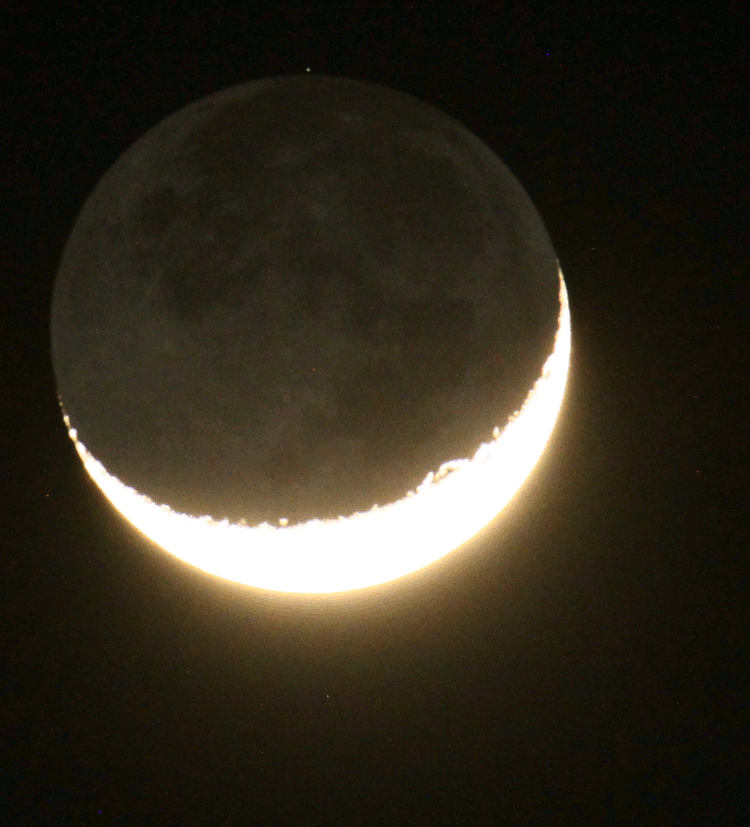We (meaning the Iconoclastic Mr Bugg and I) actually had an outing today, er, yesterday, whenever, and I have plenty of pics from that. Though I have another outing tomorrow, er, today, which should result in even more pics, but I need to get some sleep before then, so right now I’m just featuring some quick captures from this evening dark period.
I noticed when out at the lake that the moon was still a small enough crescent, close to the now-disappeared sun, that some earthshine should be visible with the right exposure. but I did not have the tripod with me at the time and attempts to brace against a tree proved worthless, so I got out the tripod on returning home and tackled the subject properly. First, the crescent in relatively normal exposure:

I need to note here that Wednesday (two, uh, three days ago, whatever) just after sunset, the moon was going to be less than 2% illuminated and right alongside Jupiter – nice little goal for a pic, if I could locate it in the twilight. And if the skies weren’t dismally overcast, which they were. I’d been thinking about it for a week ahead of time and had ruled it out that day because the sky remained grey the entire time, but then right before sunset it started clearing, and I rushed down to the lake (the best view close to the horizon.) Yet despite being blinded by the lowering sun on the drive there, not ten minutes later the sky was again a solid grey blanket without a break to be seen. What the hell, man?

But anyway, on to tonight/not. The crescent was larger than ideal for such a thing, throwing a lot of light around in the exposure that would bring up the earthshine, but it still worked just fine.

That’s not too bad really; Tycho is visible to the left, and most of the lunar mares are pretty distinct. And there’s that speck up above the moon, which really is a star – HP13579 to be exact (what an odd yet even name.)
Seeing this in the LCD after the exposure, I trotted inside to check Stellarium and confirm my suspicions. You see, while the moon is moving ‘downward’ in the direction of the crescent, that’s due to the rotation of the Earth; it’s actually moving upward, retrograde, but very slowly. Which means that the star would overtake it, and in a short period of time as well.
[Short digression here: Quite close to the moon was also Uranus, which I saw when checking Stellarium but didn’t check closely, thinking it would be too dim. It was actually magnitude 5.83 while that star up there was magnitude 7 – notably dimmer. I could easily have adjusted my framing and captured Uranus with the moon, had I looked closer before dashing back out to get the shots. Dumbass.]
There were also two stars emerging from the crescent side of the moon almost immediately before HP 13579 was to disappear, and I made the attempt, but they were magnitudes 9 and 10 and simply got lost in the glare from the crescent. But I did indeed catch HP 13579 disappearing, and made a five-frame animated gif (pronounced, “gar-çon“) to illustrate this:

The gif optimization appears to have played with the brightness of the star a little, because it was noticeably dim right before disappearing and was probably captured half-occluded. Note that all frames were firmly fixed on a tripod, so the motions you see here are actual, at least from our reference point, and the frames are each roughly nine seconds apart. Also note that the specks to the left and down below the moon are merely sensor noise, from shooting at ISO 3200 to get the earthshine without motion blur.
Nice little quick capture for the evening, but rest assured, more images will be along as soon as I can get it all together. Right now, sleep (for me, anyway – you can do what you want.)



















































